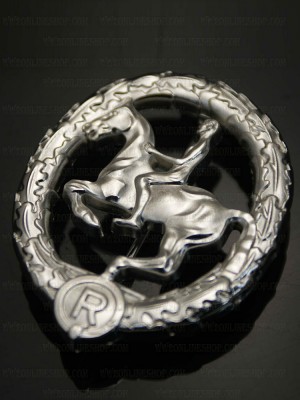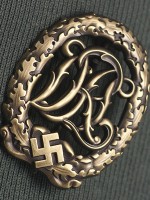Replica of German Equestrian Badge in Silver (German Riding Badge: Das Reiterabzeichen)
Availability: In Stock
German Equestrian Badge in Silver (German Riding Badge: Das Reiterabzeichen)
Here is the repro version of the Silver Grade German Equestrian Badge (German Riding Badge: Das Reiterabzeichen)
a litte history about the German Equestrian Badge (German Riding Badge: Das Reiterabzeichen):
The German Equestrian Badge was a sports decoration of the Weimar Republic and Nazi Germany which was awarded for proficiency in riding horses.
In 1930 the German Warmblood Association created a bronze, silver, and gold rider’s badge, Das Reiterabzeichen, to encourage increased equestrian knowledge and horsemanship. The bronze and sliver levels were awarded after demonstrated horsemanship and knowledge of riding theory, anatomy, and horsemastership. Since the Army was the largest equestrian organization in the country, Rittmeisters (cavalry captains) and artillery captains who were squadron or battery commanders were authorized to administer the tests and award the badges to civilians and to soldiers.
According to German cavalry historian Klaus Richter, the army made little use of the badges. This may have been because during the same period the army was in the midst of a dramatic increase in size and modernization program encouraged by the Nazis. It also may have been because military riders, as professionals, did not see a need for a badge to represent what was already represented by their rank and branch of service. It may have been that the testing for and wearing the badges was beneath the dignity of cavalrymen and horse artillerymen.
Since it was originally conceived as a civilian sports award before the Nazis came to power, it was one of the few German military qualification badges of the Nazi era that did not have a military design or include the swastika insignia.
The modern Riding Badge is still issued by the German Equestrian Association (Deutsche Reiterliche Vereinigung) and still must be earned by meeting strict criteria judged by a certified official. It looks exactly the same as the World War II and earlier version. At the copper level, level IV, the modern badge is awarded to beginner riders and is used primarily as a motivational tool to encourage a continued interest in horses. The bronze and higher requirements are more stringent. For example, a bronze level award requires successfully completing the equivalent of a USDFlevel 2 dressage test and jump course with jumps and jump combinations ranging up to 4 feet in height. There is also a written and oral test on horsemastership.
The degree of control of all horse activity in Germany has no parallel in the United States. Certainly much of that control, especially in the area of stock management and breeding, goes against the grain of American principles of free markets and individual choice. However, the ability to establish national standards in horsemanship and horsemastership creates industry standards by which one can judge riding instructors, individual ability, and stable and training facilities. It also provides a national standard against which amateur horseman can measure themselves and towards which they can work improve their horsemanship. The U.S. Pony Club standards are probably the only U.S. measure which is similar.
Write a review
Your Name:Your Review: Note: HTML is not translated!
Rating: Bad Good
Enter the code in the box below:





















